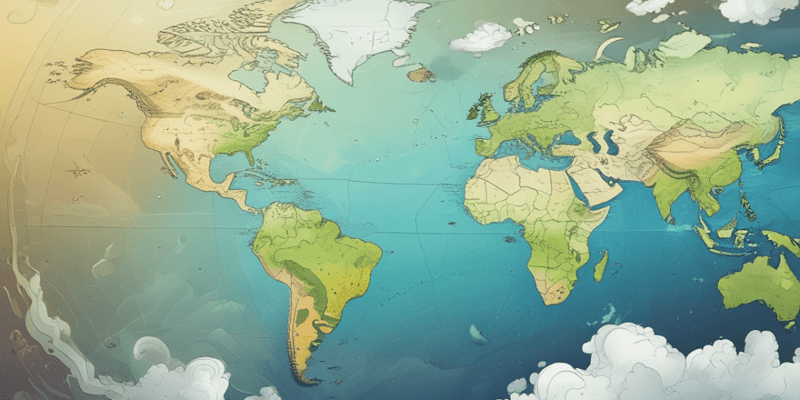Podcast
Questions and Answers
What primarily causes the different climate zones on Earth?
What primarily causes the different climate zones on Earth?
Which climate zone is characterized by consistently cold temperatures with longer winters and shorter summers?
Which climate zone is characterized by consistently cold temperatures with longer winters and shorter summers?
How does the angle at which sunlight hits the Earth change as you move away from the equator?
How does the angle at which sunlight hits the Earth change as you move away from the equator?
Which factors, besides sunlight, influence climate zones?
Which factors, besides sunlight, influence climate zones?
Signup and view all the answers
Which climate zone typically has the highest amount of solar energy received?
Which climate zone typically has the highest amount of solar energy received?
Signup and view all the answers
Why do the polar regions receive less solar energy compared to regions near the equator?
Why do the polar regions receive less solar energy compared to regions near the equator?
Signup and view all the answers
In which climate zone is it very warm and dry in summer, but extremely cold with frozen water and white snow landscapes in winter?
In which climate zone is it very warm and dry in summer, but extremely cold with frozen water and white snow landscapes in winter?
Signup and view all the answers
Which two characteristics of a continent influence the presence of the polar climate zone?
Which two characteristics of a continent influence the presence of the polar climate zone?
Signup and view all the answers
Which climate zone has consistently warm temperatures, heavy rainfall throughout the year, and greater temperature differences between day and night than between different months?
Which climate zone has consistently warm temperatures, heavy rainfall throughout the year, and greater temperature differences between day and night than between different months?
Signup and view all the answers
Which climate zone has warm to hot and dry conditions in summer, and mild and wetter conditions in winter?
Which climate zone has warm to hot and dry conditions in summer, and mild and wetter conditions in winter?
Signup and view all the answers
Which two continents can be considered the largest climate zones?
Which two continents can be considered the largest climate zones?
Signup and view all the answers
Which continent lies within four climate zones and what are these climate zones?
Which continent lies within four climate zones and what are these climate zones?
Signup and view all the answers
Which continents are in three climate zones and what are the names of these climate zones?
Which continents are in three climate zones and what are the names of these climate zones?
Signup and view all the answers
Which continent has only one climate zone and what is the name of that climate zone?
Which continent has only one climate zone and what is the name of that climate zone?
Signup and view all the answers
Study Notes
Climate and Climate Zones
- The Earth is divided into zones with different temperatures, known as climate zones, due to the varying latitudes and sun's radiation.
- The differences in temperature arise from the unequal sun's radiation, which decreases as one moves away from the equator.
- The sun's radiation not only affects temperature but also the course of the seasons.
Climate Zones
- Polar Climate Zone: Extremely cold in winter, with frozen water and snow-covered landscapes, and warm in summer.
- Tropical Climate Zone: Warm temperatures throughout the year, high rainfall, and larger temperature differences between day and night than between seasons.
- Subtropical Climate Zone: Warm to hot in summer, mild and humid in winter, with significant temperature differences between seasons.
- Subpolar Climate Zone: Consistently cold, with long winters and short summers.
- Temperate Climate Zone: Moderate temperatures, with four distinct seasons.
Continents and Climate Zones
- Asia and Africa: The largest continents, covering multiple climate zones.
- Europe: Covers four climate zones: polar, subpolar, temperate, and subtropical.
- Australia and Oceania: Covers three climate zones: tropical, subtropical, and temperate.
- Africa: Covers two climate zones: subtropical and tropical.
- Antarctica: Covers the polar climate zone.
Studying That Suits You
Use AI to generate personalized quizzes and flashcards to suit your learning preferences.
Description
This quiz tests your knowledge of different climate zones, including the polar climate zone, and the factors that influence their formation. Learn about the characteristics of each climate zone and more!




